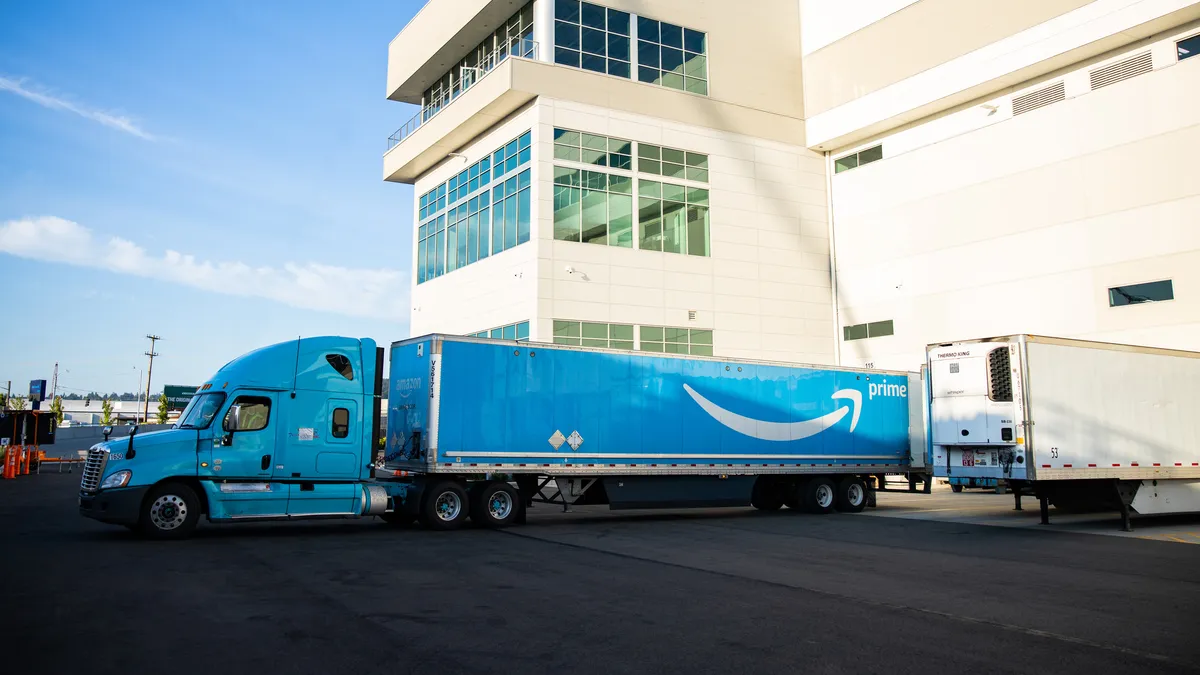Dive Brief:
-
Amazon on Thursday unveiled "Buy with Prime," where Prime members can shop on websites outside of Amazon, using their saved checkout details and enjoying Prime benefits like free, fast delivery and free returns.
-
At first the program, which is rolling out this year, will be available invite-only to Amazon marketplace sellers using Fulfillment by Amazon, but will eventually include non-FBA Amazon sellers as well as retailers and brands not otherwise affiliated with Amazon.
-
Participating sellers and retailers will pay service fees, payment processing fees, and fulfillment and storage fees calculated per unit, Amazon said in a corporate blog post.
Dive Insight:
Buy with Prime furthers Amazon's domination of retail, without having to operate much like a retailer at all.
"It's been coming for a long time," Rick Watson, founder and CEO of RMW Commerce Consulting, said by phone. "They doubled their fulfillment network last year, and it was pretty obvious that, based on that, they were going to open up their fulfillment platform to non-Amazon merchants."
Besides its obvious non-retail operations like its Prime video streaming service or money-making AWS cloud service, the e-commerce giant seems more focused on monetizing its relationships with other merchants than on selling goods itself.
The company recently shut down much of its brick-and-mortar fleet outside of its Whole Foods grocery locations. Meanwhile, its marketplace, responsible for selling most of the goods available through its site, is lucrative thanks to fees covering sales, fulfillment and advertising. In a week, Amazon marketplace sellers face a 5% fuel and inflation surcharge, on top of fees already hiked in January
"With growth from its core retail business slowing, Amazon is looking for new ways to bolster revenue," GlobalData Managing Director Neil Saunders said in emailed comments. "Buy with Prime is one of the initiatives it hopes will provide a new avenue for success."
In addition to stoking its retail-adjacent profit center, Amazon's new Buy with Prime option offers subscribers a reason to hang onto their Prime membership, which also got more expensive this year.
"We always aim to exceed Prime members' expectations by offering more selection, exclusive deals, quality content, and convenient features," Amazon Prime Vice President Jamil Ghani said in a statement.
Buy with Prime seems destined to count as a fresh advantage for Amazon, which is being buffeted from various sides of late, including rising fuel costs, slowing e-commerce, ongoing global supply chain issues and unionization — in a consumer environment colored by inflation, shifts in spending priorities and a renewed preference for physical stores. Members of Congress are also contemplating action against the sale of what they warn are sub-par goods and evaluating whether Amazon's conduct runs afoul of antitrust regulations, while the federal government investigates its business practices. The e-retailer is also facing more competition, not just from legacy retailers like Target that have beefed up their digital operations but also services like Shopify, Instacart and Walmart's GoLocal.
But the move isn't without its risks. Buy with Prime could cannibalize Amazon's marketplace at a time when its growth is already slowing, according to Saunders. And Amazon is essentially selling one of its own advantages by offering Prime benefits to outside retailers, so it needs to be choosy. Finally, one of the upsides of Buy with Prime — access to customer data — could deter some retailers or brands from participating.
The service won't be a way to woo back Nike, Target or any other big players that once partnered with Amazon but have grown protective of their customer relationships and sales data. "It was totally a trap," Watson said. "And this is also totally a trap."
But smaller retailers will have access to the Prime membership base and a way to improve what for most is a sub-par delivery offer, according to Watson. The program allows marketplace sellers to reach Prime customers through their own sites, but also entices brands reluctant to be found on Amazon, according to Saunders.
One question is whether merchants operating via Shopify will be able to add a Buy with Prime button to their sites, Watson noted.
"BigCommerce, who is a small Shopify competitor, partners with Amazon and this program seems natural for them and maybe Adobe or Salesforce, to the extent that they want to partner with Amazon," Watson said. "But Shopify seems like a bridge too far."













